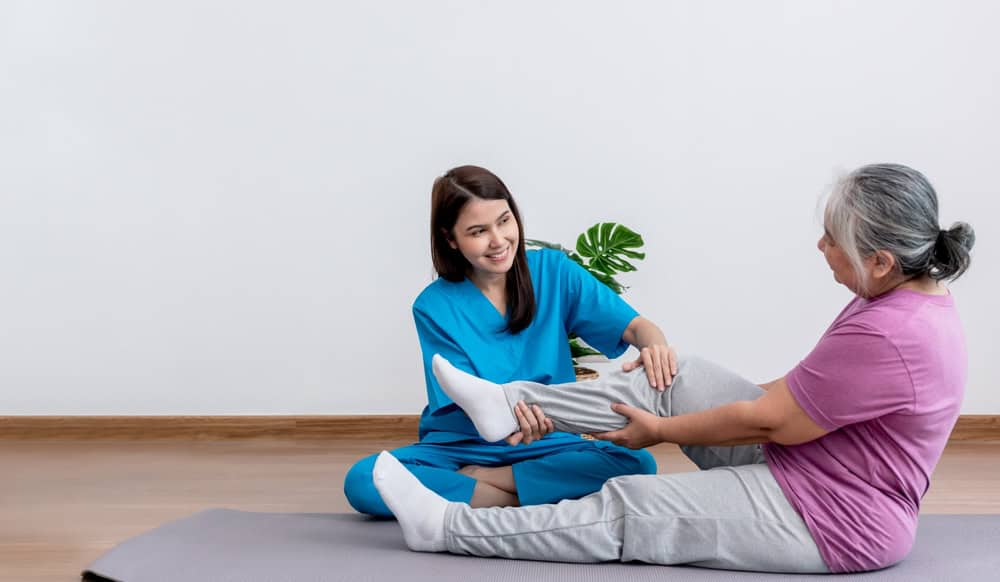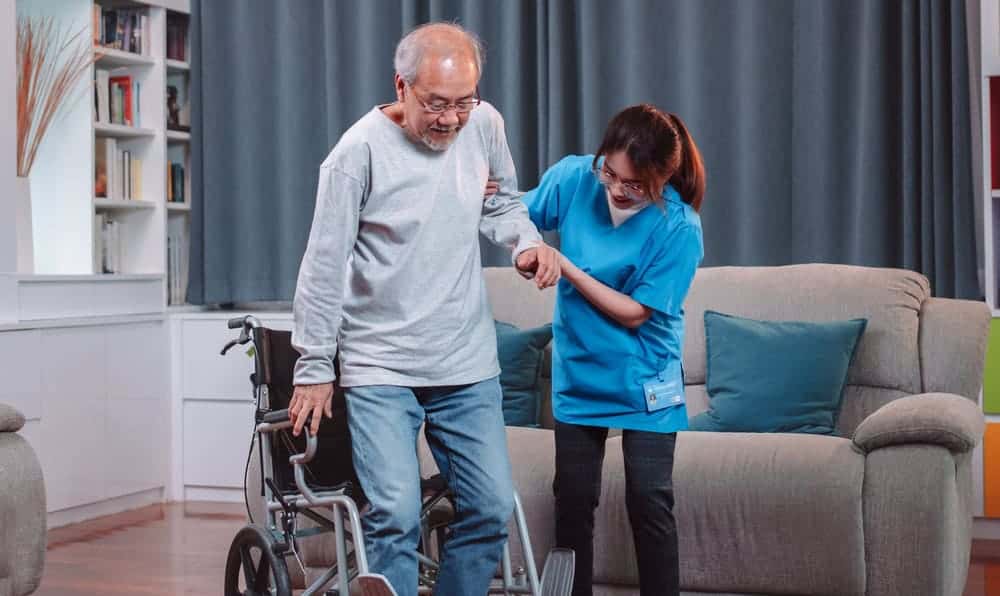
Aging is a gift. The gift to live out your life, make memories, and gain experiences. However, only a few get to grow old without having one health complication or the other.
As we get older, our bodies begin to wear out. Muscle loss, loss of physical abilities, and the onset of medical conditions can impact our quality of life.
Physical therapy can help treat some health conditions that affect our mobility. Physical therapists work with you to develop a plan to restore or maintain physical function and mobility.
In this article, we explore 21 ailments treated by physical therapy. If you or your loved one is suffering from any of these diseases and conditions, physical therapy is an effective treatment option.
Benefits of Physical Therapy for Seniors
Physical therapy benefits seniors in a variety of ways. From pain reduction to restoring mobility, or preventing falls, physical therapy can help improve function.
Improves Mobility
Physical therapy helps seniors move more easily by strengthening muscles and increasing flexibility. This makes daily activities like walking, climbing stairs, and getting in and out of chairs much easier and safer.
Reduces Pain
Physical therapy can decrease pain from conditions like arthritis and back problems. Therapists use special exercises and treatments like heat, cold, and massage to relieve pain and improve comfort, helping seniors feel better day-to-day.
Prevents Falls
Balance and coordination exercises in physical therapy help seniors stay steady on their feet. This reduces the risk of falls and serious injuries, such as hip fractures.
Enhances Independence
By improving strength, mobility, and coordination, physical therapy allows seniors to perform daily tasks like dressing, bathing, and cooking on their own. This boosts their confidence and helps them maintain their independence.

Promotes Overall Health
Regular physical activity through therapy improves heart health, mood, and energy levels. It also helps manage chronic conditions like diabetes and high blood pressure, contributing to a better overall quality of life.
What To Expect From Physical Therapy
What should you or your loved one expect from a typical physical therapy program?
- Initial Evaluation: Your first visit will include an evaluation. The therapist will ask about your medical history and current issues. They will check your strength, balance, and range of motion to create a personalized treatment plan.
- Customized Exercise Plan: You’ll get a set of exercises tailored to your needs. These might include stretching, strength training, and balance exercises. Your therapist will show you how to do them correctly.
- Hands-On Treatment: Physical therapy often includes hands-on treatments like massage or joint mobilization. These help to reduce pain, improve mobility, and increase circulation.
- Progress Monitoring: Your therapist will track your progress and adjust your treatment plan as needed. They will make sure you are improving and reaching your goals.
- Home Exercise Program: You’ll receive exercises to do at home between sessions. Following this home program is crucial for your recovery and continued improvement.
Your timeline for recovery will be unique. Depending on your condition, how your body responds to treatment, and your commitment, this will range anywhere from a few weeks to months or years.
Regardless, after mobility and function are restored, it’s important to maintain an average level of physical activity each day to promote overall health.
Ailments Treated By Physical Therapy
Here are 22 common conditions and diseases treated by physical therapy.
1. Arthritis
Arthritis is a form of musculoskeletal disorder that involves inflammation of the joints, causing pain and stiffness. Physical therapy helps manage arthritis through exercises that improve joint mobility and strengthen surrounding muscles, reducing pain and enhancing function.
2. Osteoporosis
Osteoporosis is a condition where bones become weak and brittle. Physical therapy includes weight-bearing and resistance exercises to strengthen bones, reduce fracture risk, and improve overall bone health.

3. Parkinson’s Disease
Parkinson’s is a neurodegenerative disorder affecting movement. Physical therapy enhances movement, balance, and coordination with specialized exercises, reducing fall risk and improving daily functioning.
4. Stroke Recovery
A stroke occurs when blood flow to the brain is interrupted, affecting motor skills. Physical therapy helps stroke survivors regain strength, coordination, and motor skills through targeted exercises and movement re-education.
5. Hip Fractures
Hip fractures are breaks in the upper part of the thigh bone. Post-surgery physical therapy focuses on restoring hip movement and strength, aiding in quicker and safer recovery.
6. Knee Replacement
Knee replacement involves replacing a damaged knee joint with an artificial one. Physical therapy post-surgery helps improve knee flexibility and strength, speeding up recovery and restoring normal function.
7. Chronic Obstructive Pulmonary Disease (COPD)
COPD is a chronic lung disease that obstructs airflow. Physical therapy includes breathing exercises and endurance training to improve lung function and overall physical endurance.
8. Heart Disease
Heart disease encompasses various heart conditions that affect heart function. Cardiac rehabilitation through physical therapy includes monitored exercise programs to strengthen the heart and improve cardiovascular health.

9. Alzheimer’s Disease
Alzheimer’s is a progressive brain disorder that affects memory and cognitive function. Physical therapy focuses on maintaining mobility, balance, and physical activity levels, helping manage symptoms, and improving quality of life.
10. Multiple Sclerosis (MS)
MS is a disease where the immune system attacks the protective covering of nerves. Physical therapy helps manage MS symptoms by improving strength, balance, and mobility through customized exercise plans.
11. Sciatica
Sciatica is pain that radiates along the sciatic nerve from the lower back down to the legs. Physical therapy uses specific exercises and stretches to relieve sciatic nerve pain and improve flexibility and strength in the lower back and legs.
12. Chronic Pain
Chronic pain is ongoing pain that lasts longer than six months. Physical therapy uses a combination of exercises, manual therapy, and pain relief techniques to manage chronic pain conditions, helping improve function and quality of life.
13. Rotator Cuff Injuries
Rotator cuff injuries involve tears or inflammation in the shoulder muscles and tendons. Physical therapy helps by strengthening shoulder muscles and improving range of motion, promoting healing and reducing pain.
14. Balance Disorders
Balance disorders affect stability and increase the risk of falls. Physical therapy includes balance training and strength exercises to improve stability and prevent falls, enhancing overall safety and confidence.

15. Carpal Tunnel Syndrome
Carpal tunnel syndrome is a condition caused by compression of the median nerve in the wrist. Physical therapy helps reduce pain and improve hand function through wrist and hand exercises and manual therapy.
16. Incontinence
Incontinence is the inability to control urination or bowel movements. Physical therapy helps manage incontinence through pelvic floor exercises that strengthen the muscles controlling bladder and bowel functions, improving control and reducing episodes.
17. Cancer
Cancer is a disease where abnormal cells divide uncontrollably and destroy body tissue. Physical therapy for cancer patients focuses on maintaining strength, mobility, and function during and after treatment, helping manage fatigue and improve quality of life.
18. Vertigo
Vertigo is a sensation of spinning or dizziness often caused by inner ear problems. Physical therapy, specifically vestibular rehabilitation, includes exercises to improve balance and reduce dizziness, helping patients manage vertigo symptoms effectively.
19. Chronic Fatigue Syndrome (CFS)
Chronic Fatigue Syndrome is a long-term illness characterized by extreme fatigue. Physical therapy helps manage CFS through graded exercise therapy, which gradually increases physical activity levels to improve endurance and reduce fatigue.
20. Lymphedema
Lymphedema is swelling due to the build-up of lymph fluid, often in the arms or legs. Physical therapy includes manual lymphatic drainage, compression therapy, and exercises to reduce swelling and improve lymphatic flow.
21. Depression and Anxiety
These are mental health conditions that affect mood and energy levels. Physical therapy can include exercise programs that boost mood, improve sleep, and increase energy levels, contributing to overall mental health.
How To Get Started With Physical Therapy For Your Loved One
If your loved one has a condition treated by physical therapy, here is how to find a physical therapist and get started.
Consult with a Healthcare Provider
The first step is to schedule an appointment and consult with your loved one’s primary care physician or specialist to discuss the need for physical therapy. The doctor can provide a referral to a physical therapist who specializes in geriatric care.
Find a Qualified Physical Therapist
The next step is to research and look for licensed physical therapists with experience in treating seniors, and the condition of your loved one. You can search online or ask for recommendations from healthcare providers or friends. Ensure the therapist is certified and has a good track record in geriatric physical therapy.
Schedule an Initial Evaluation
This will help the therapist determine the specific needs, and create a personalized treatment plan. Gather any relevant medical records, a list of current medications, and information about past surgeries or treatments.
Attend Therapy Sessions
Your loved one must attend the therapy sessions regularly as prescribed by the therapist. This guarantees the effectiveness of their program. Their therapist may provide exercises to be done at home between sessions as well.

For home exercises, make necessary adjustments at home to ensure a safe environment, such as removing tripping hazards and installing grab bars if needed.
Monitor Progress
Keep an eye on the progress and note any improvements or challenges. Communicate regularly with your therapist about how you feel at any point. Your therapist will continue to adjust the treatment plan as needed.
Improve The Quality Of Your Life With Physical Therapy
Even common issues such as headaches, back pain, or neck pain can be treated with physical therapy. Having the freedom of movement to live out your golden years is precious, and physical therapy can help you or your loved one achieve that.
If you’re looking for the best physical therapists in Nevada, Amy’s Eden partners with licensed therapists to provide quality care for our seniors. Care can be provided in our assisted homes or your home.
Contact us today to learn more about our services, and how we can help your loved one restore physical function.




